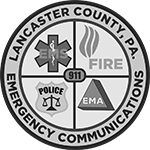Radio System FAQs
1. What is the new radio system?
As a result of a contract signed by the Lancaster County Board of Commissioners and ARINC on Wednesday, August 1, 2012, the Project 25 (P-25) UHF T-Band Digital Trunked radio system was deployed in 2013.
2. What is included in the project?
The project includes upgraded dispatch consoles, core system equipment, tower site equipment, dispatch alphanumeric paging system, and other related equipment associated with the county’s communications center and dispatch capabilities.
3. What is P25?
P-25 is the standard for the design and manufacture of interoperable digital two-way wireless communications products. Developed in North America with state, local and federal representatives and Telecommunications Industry Association (TIA) governance, P-25 has gained worldwide acceptance for public safety, security, public service, and commercial applications.
The published P-25 standards suite is administered by the Telecommunications Industry Association (TIA Mobile and Personal Private Radio Standards Committee TR-8). Radio equipment that demonstrates compliance with P-25 is able to meet a set of minimum requirements to fit the needs of public safety. The P-25 standard was created by and is intended for, public safety professionals.
4. What is T-Band?
T-Band is UHF radio frequency spectrum from 470-512 MHz. The FCC made a decision to allocate TV channels 14-20 for use in the public safety sector in larger metropolitan areas. The assignments within this range are typically called T-Band, named for their using the Television Band frequencies for two-way radio communication.
5. What is trunking?
There are two types of radio systems: conventional and trunked. In a conventional system, the radio message between the station and units in the field occur on one frequency. At any given time, some of the frequencies or channels may be so busy that messages are delayed or "stepped on," while other channels are lightly used or not used at all. When several departments share a single frequency, they may cause interference with each other. This was the case with Lancaster County’s conventional frequencies. Trunking is a method that utilizes all frequencies within a radio system to its maximum potential. In a trunked system, all radio system users share all the frequencies. When a transmission occurs between two radio system users, the trunked system automatically selects an unused frequency and switches all radios in the system to that frequency. No one radio frequency is assigned to any one department and the frequency could change every time a transmission is made. Instead of talking on a specific radio frequency, as users did on the conventional system, a user in a trunked radio system utilizes “talkgroups.”
6. Which radios will be permitted on the system?
Authorized Motorola models are available here.
Authorized Relm models are available here.
Authorized Harris models are available here.
Authorized TAIT models are available here.
Authorized Kenwood models are available here.
7. Pyramid Repeaters and the new system
Pyramid and Motorola repeaters are authorized on the P-25 UHF T-Band Digital Trunked radio system. Consult LCWC radio technicians for specific requirements.
8. What radio system coverage can I expect from the new system?
The county requested that the design of the radio system maintain at least 95% reliability, 95% of the time for in-building, on-hip portable radio coverage. In contrast, the conventional radio system was never built as a single system but rather it was a patchwork of radio tower sites with add-ons introduced as needs arose. It was never designed to provide in-building portable radio coverage.
9. Describe communication and interoperability with agencies from other counties?
The network contains interoperability features for units responding into, or out of Lancaster County. Interoperability includes microwave connectivity to the 8-county regional microwave system; authorized sharing of compatible, regional, county talkgroups; the ability to patch talkgroups together; and the availability of national common talkgroups.
10. Who may purchase and use radios on the system?
Only authorized local, county, state, and federal agencies are permitted to purchase and use radios on the system.
11. Where may radio system questions be directed?
Questions can be submitted through the Feedback Form on this website.
12. What can a scanner enthusiast expect from the radio system?
Conventional scanners are not capable of decoding digital voice data. The P-25 UHF T-Band Digital Trunked radio system can be monitored by any scanner that is APCO P-25 Phase 2 capable, or online at either broadcastify.com, or radioreference.com. Scanner programming information can be found at radioreference.com. Law enforcement talkgroup audio is encrypted and unable to be monitored.


